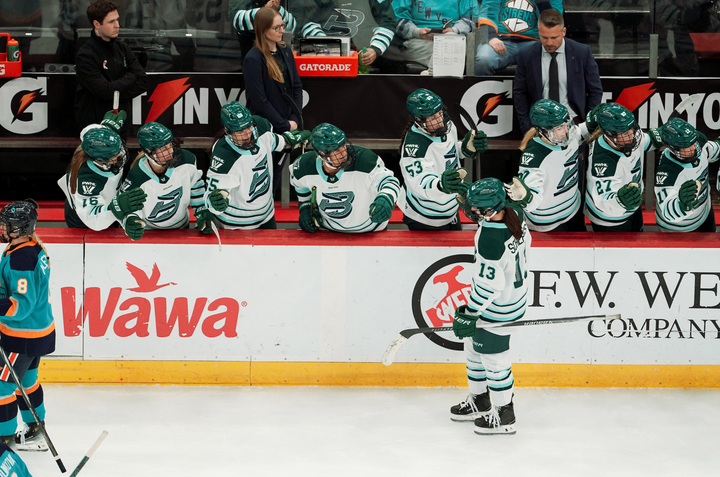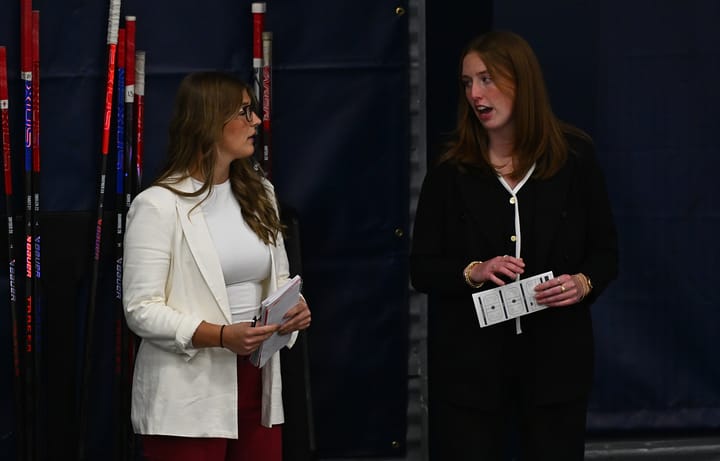A Look at the New Wave of NWHL Goaltenders
Context and expectations for analyzing NWHL goalies with stats
The current two-week break in the NWHL’s regular season schedule provides us with a unique opportunity to analyze and evaluate the play of the league’s goaltenders. But, before we jump into looking at some small sample sizes, let’s provide some context and expectations for analyzing NWHL goalies with stats.
Some History
In August, HockeyGraphs.com published a project I worked on over the summer titled “Revisiting NWHL Game Score” — in which I added to the foundation created by Shawn Ferris in March 2018. In that piece, I made the following observation:
Unfortunately, there are several factors that ultimately limit how we can use game score with goaltenders. Together, the brevity of the NWHL season, the size of the league, and frequent roster turnover result in an inadequate amount of data for predicting goaltending performance with game score. As things currently stand, there just isn’t enough data to test for repeatability.
Unfortunately, the factors listed above are not just problematic for the application of game score; they’re problematic for all comparative statistical analysis NWHL goaltenders. Outside of the work of Alyssa Longmuir and her collaborators at Even-Strength.com and the work of Crease Giants, there is a scant amount of data available for NWHL goaltenders.
As a matter of fact, I only completed my counting stats project for goalies through the first four NWHL seasons yesterday.
(Finally) presenting @NWHL All-Time Goalie stats from the league's first 4 years.
— Mike Murphy (@DigDeepBSB) November 5, 2019
- #NWHL avg Sv% heading into 2019-20: .904
- Starts, individual records, Sv%, GSAA, GSAA60, SA60, GAA, MIN
- I hope to add more categories when/if I find the time.https://t.co/62CFpBeOgm
Of course, the 2019-20 NWHL regular season will be the longest to date, with 24 games scheduled. This extended schedule promises to bring with it larger sample sizes to compare the performances of skaters, teams, and goaltenders. In other words, it’s music to the ear of a stats dork.
The Data Through October 2019
At the break, each NWHL team has played at least five games, which gives us a small but intriguing sample size. Why intriguing? Because seven of the 10 goaltenders who have stopped pucks thus far are new to the league and one of the three veterans — Amanda Leveille — is the new all-time leader in wins.
Enough with the words, let’s get to the numbers.
NWHL Goaltending Data Through 10/31/19
| Team | Player | Rk | Nat | Program | GP | GS | W | MINd | SA | SV | GA | SA60 | Sv% | PP GA | ES GA | SH GA | SO | GAA | GSAA | GSAA/60 |
|---|---|---|---|---|---|---|---|---|---|---|---|---|---|---|---|---|---|---|---|---|
| MIN | Amanda Leveille | CAN | D-I | 6 | 6 | 3 | 360.08 | 198 | 180 | 18 | 32.99 | 0.909 | 3 | 15 | 3.00 | 4.572 | 0.762 | |||
| MIN | Allie Morse | Y | USA | D-I | 0 | 0 | 0 | |||||||||||||
| MET | Sam Walther | USA | D-III | 5 | 5 | 1 | 268.87 | 203 | 179 | 24 | 45.30 | 0.882 | 7 | 15 | 2 | 5.36 | -0.858 | -0.191 | ||
| MET | Dana DeMartino | Y | USA | D-III | 1 | 0 | 0 | 30.82 | 17 | 14 | 3 | 33.10 | 0.824 | 1 | 2 | 5.84 | -1.062 | -2.067 | ||
| CTW | Sonjia Shelly | Y | USA | D-I | 5 | 5 | 0 | 265.7 | 137 | 120 | 17 | 30.94 | 0.876 | 6 | 11 | 3.84 | -1.382 | -0.312 | ||
| CTW | Cassandra Goyette | Y | USA | D-III | 1 | 1 | 0 | 20 | 11 | 7 | 4 | 33.00 | 0.636 | 2 | 2 | 12.00 | -2.746 | -8.238 | ||
| CTW | Brooke Wolejko | Y | USA | D-I/D-III | 0 | 0 | 0 | 17.3 | 6 | 5 | 1 | 20.81 | 0.833 | 3.47 | -0.316 | -1.096 | ||||
| BUF | Mariah Fujimagari | Y | CAN | D-I | 5 | 4 | 2 | 242.43 | 142 | 126 | 16 | 35.14 | 0.887 | 3 | 13 | 3.96 | 0.188 | 0.047 | ||
| BUF | Kelsey Neumann | USA | D-I/D-III | 2 | 1 | 1 | 62.17 | 36 | 31 | 5 | 34.74 | 0.861 | 5 | 4.83 | -0.896 | -0.865 | ||||
| BOS | Victoria Hanson | Y | USA | D-I | 2 | 0 | 0 | 37.03 | 17 | 16 | 1 | 27.55 | 0.941 | 1 | 1.62 | 0.938 | 1.520 | |||
| BOS | Lovisa Selander | Y | SWE | D-I | 7 | 7 | 7 | 382.97 | 217 | 206 | 12 | 34.00 | 0.949 | 4 | 7 | 1.88 | 12.738 | 1.996 |
Early Impressions
Boston Pride
It goes without saying that Lovisa Selander is having a historically significant start to her NWHL career with the Boston Pride. Selander’s .949 save percentage in her first seven starts stands above Jaimie Leonoff’s .943 save percentage in the first seven appearances of her peerless 2015-16 season. She’s also faced an average workload of 34.0 SA60, which is likely a result of Boston’s free-flowing style of play.
In other words, Selander has leveled the competition in her first month of professional hockey in North America.
What stands out the most about Selander’s play thus far is how calm, cool, and collected she looks in net. Her 5-foot-11 frame and sound positioning have proven to be nearly impregnable to the NWHL’s shooters. Although it’s worth mentioning that Riveters rookie Kendall Cornine has beat her three times in three games. Still, Selander’s 1.99 GSAA/60 (goals saved above average per-60 minutes) is in a league of its own among the league’s starters.
Connecticut Whale
After October, the Whale’s .859 Team Sv% is the worst in the league. However, their 30.73 SA60 is the best in the league.
Naturally, the Whale’s abysmal 47.62 percent success rate on the penalty kill has dragged those numbers down — so too has a five game sample size — but there are definitely question marks in the goal crease and defensive zone for the Whale. Thus far, the Whale’s best goaltender has been St. Lawrence alumna Sonjia Shelly. Her .876 save percentage hardly jumps off the page, but six of the 17 goals that have gotten past her were scored when Connecticut was shorthanded.
It’s still early, but no team misses their 2018-19 starter as much as the Whale miss Meeri Räisänen.
Buffalo Beauts
The Beauts are the only team with two goaltenders who have earned a win. Mariah Fujimagari’s .887 Sv% is ranked third in the league among starting goaltenders. That number would be significantly higher if Buffalo hadn’t played two games against the Pride, including an 8-1 loss in which Fujimagari allowed five goals on 16 shots.
Heading into this season, Fujimagari was expected to be the starter after honing her craft with the Worcester Blades in the CWHL last season after spending a year in the EWHL. Through 242:26, she’s looked like the starting goaltender the Beauts were hoping she’d be. She’s also allowed just three power play goals in five appearances this season.
NWHL veteran Kelsey Neumann earned her first career win on Oct. 20th in a game she was forced to exit early due to an injury. However, her best performance to date in her NWHL career came in relief of Fujimagari on Oct. 13 when she stopped 23 of the 26 shots she faced from the Pride. It’s a small sample size for Neumann, but she has been solid for Buffalo in just over 62 minutes of hockey. Hopefully, she’ll stay healthy and earn more playing time. She has definitely earned it.
Minnesota Whitecaps
Amanda Leveille is the only goalie in the NWHL to play every minute of action for her team. Of course, that isn’t much of a surprise. Leveille started in 15 of the Whitecaps’ 16 games last year and started in all 16 games for the Beauts in the 2017-18 season. She’s a workhorse starting goaltender in the NWHL just like she was at the University of Minnesota.
The NWHL’s all-time leader in wins (30) has a .909 Sv% in six starts at the break, which is second only to Selander. Heading into the season, Leveille’s career Sv% was .914, so she’s definitely in the neighborhood we expected her to be in. That percentage would also look a lot different if not for the Whitecaps’ rocky road trip into Boston.
The bottom line is that Leveille is the most experienced goaltender in the league and is Selander’s biggest competition for Goaltender of the Year. She’s the complete package. As the season progresses, she will be the goalie that we measure Selander and the rest of the newcomers against.
Metropolitan Riveters
Prior to this season, Sam Walther had played less than 12 minutes of professional hockey and allowed two goals on six shots against. So, expectations were not exactly high for the Hamilton College alumna. In five starts and 268:52 minutes of hockey she’s proven a lot of people — myself included — wrong.
While it’s true that the average save percentage through the NWHL’s first four seasons is .904, Walther’s .882 Sv% stands out because the league average for 2019-20 at this juncture is .897 and no goaltender has had a more difficult schedule or workload. Walther’s 45.30 SA60 is on another planet. Her closest competitor in terms of average shot volume faced is Fujimagari’s 35.14 SA60. Walther has undoubtedly been the NWHL’s busiest goalie.
Walther is one five goalies with ties to an NCAA D-III hockey program who has seen action between the pipes this season. Thus far, her performance has undoubtedly been the most impressive. How Walther and the NWHL’s other D-III alumnae continue to adjust to the NWHL game will be a key storyline to follow when the season resumes.
All data courtesy of NWHL.zone and the author’s own tracking. Video clips from twitch.tv/nwhl, twitch.tv/nwhl2, and twitch.tv/goalieguild.
Disclosure: the author of this piece is currently employed by the NWHL.





Comments ()